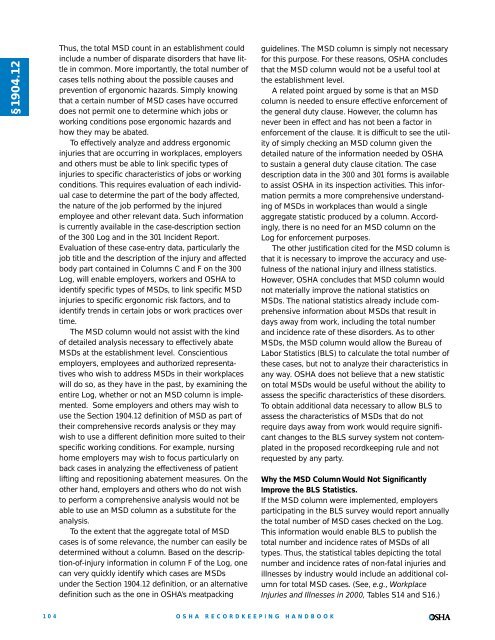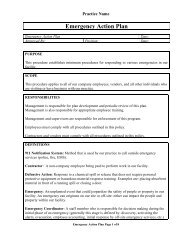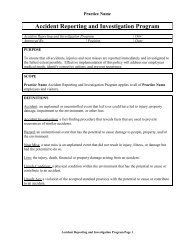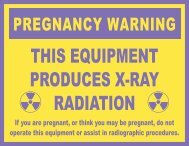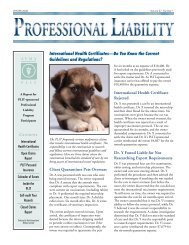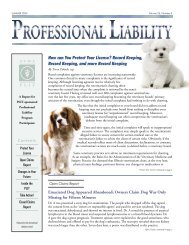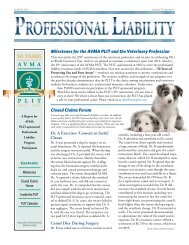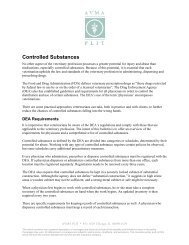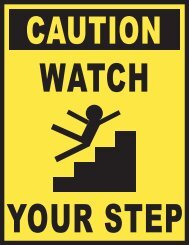§1904.12Thus, the total MSD count in an establishment couldinclude a number of disparate disorders that have littlein common. More importantly, the total number ofcases tells nothing about the possible causes andprevention of ergonomic hazards. Simply knowingthat a certain number of MSD cases have occurreddoes not permit one to determine which jobs orworking conditions pose ergonomic hazards andhow they may be abated.To effectively analyze and address ergonomicinjuries that are occurring in workplaces, employersand others must be able to link specific types ofinjuries to specific characteristics of jobs or workingconditions. This requires evaluation of each individualcase to determine the part of the body affected,the nature of the job performed by the injuredemployee and other relevant data. Such informationis currently available in the case-description sectionof the 300 Log and in the 301 Incident Report.Evaluation of these case-entry data, particularly thejob title and the description of the injury and affectedbody part contained in Columns C and F on the 300Log, will enable employers, workers and <strong>OSHA</strong> toidentify specific types of MSDs, to link specific MSDinjuries to specific ergonomic risk factors, and toidentify trends in certain jobs or work practices overtime.The MSD column would not assist with the kindof detailed analysis necessary to effectively abateMSDs at the establishment level. Conscientiousemployers, employees and authorized representativeswho wish to address MSDs in their workplaceswill do so, as they have in the past, by examining theentire Log, whether or not an MSD column is implemented.Some employers and others may wish touse the Section 1904.12 definition of MSD as part oftheir comprehensive records analysis or they maywish to use a different definition more suited to theirspecific working conditions. For example, nursinghome employers may wish to focus particularly onback cases in analyzing the effectiveness of patientlifting and repositioning abatement measures. On theother hand, employers and others who do not wishto perform a comprehensive analysis would not beable to use an MSD column as a substitute for theanalysis.To the extent that the aggregate total of MSDcases is of some relevance, the number can easily bedetermined without a column. Based on the description-of-injuryinformation in column F of the Log, onecan very quickly identify which cases are MSDsunder the Section 1904.12 definition, or an alternativedefinition such as the one in <strong>OSHA</strong>’s meatpackingguidelines. The MSD column is simply not necessaryfor this purpose. For these reasons, <strong>OSHA</strong> concludesthat the MSD column would not be a useful tool atthe establishment level.A related point argued by some is that an MSDcolumn is needed to ensure effective enforcement ofthe general duty clause. However, the column hasnever been in effect and has not been a factor inenforcement of the clause. It is difficult to see the utilityof simply checking an MSD column given thedetailed nature of the information needed by <strong>OSHA</strong>to sustain a general duty clause citation. The casedescription data in the 300 and 301 forms is availableto assist <strong>OSHA</strong> in its inspection activities. This informationpermits a more comprehensive understandingof MSDs in workplaces than would a singleaggregate statistic produced by a column. Accordingly,there is no need for an MSD column on theLog for enforcement purposes.The other justification cited for the MSD column isthat it is necessary to improve the accuracy and usefulnessof the national injury and illness statistics.However, <strong>OSHA</strong> concludes that MSD column wouldnot materially improve the national statistics onMSDs. The national statistics already include comprehensiveinformation about MSDs that result indays away from work, including the total numberand incidence rate of these disorders. As to otherMSDs, the MSD column would allow the Bureau ofLabor Statistics (BLS) to calculate the total number ofthese cases, but not to analyze their characteristics inany way. <strong>OSHA</strong> does not believe that a new statisticon total MSDs would be useful without the ability toassess the specific characteristics of these disorders.To obtain additional data necessary to allow BLS toassess the characteristics of MSDs that do notrequire days away from work would require significantchanges to the BLS survey system not contemplatedin the proposed recordkeeping rule and notrequested by any party.Why the MSD Column Would Not SignificantlyImprove the BLS Statistics.If the MSD column were implemented, employersparticipating in the BLS survey would report annuallythe total number of MSD cases checked on the Log.This information would enable BLS to publish thetotal number and incidence rates of MSDs of alltypes. Thus, the statistical tables depicting the totalnumber and incidence rates of non-fatal injuries andillnesses by industry would include an additional columnfor total MSD cases. (See, e.g., WorkplaceInjuries and Illnesses in 2000, Tables S14 and S16.)104<strong>OSHA</strong> RECORDKEEPINGHANDBOOK
These new statistics would add only marginally tothe information currently available. As describedabove, the BLS case characteristic data already presenta comprehensive picture of the most severeMSDs, including separate statistics on the total numberand incidence rate of these disorders. Accordingly,the MSD column would add minimally to thenational statistics on MSDs that resulted in daysaway from work.The new data would be relevant primarily for thepurpose of estimating the number of MSDs that donot result in days away from work. The number ofthese MSDs could be approximated by subtractingthe number of days away from work MSD casesreported by BLS from the total number of MSDs ofall types produced by the column. However this estimatewould have limited utility because the absenceof case characteristic data for cases that do not resultin days away from work MSDs precludes analysis ofthem.As noted above, the BLS survey elicits descriptiveinformation only on injuries and illnesses, includingMSDs, resulting in days away from work. The BLSdatabase of case-characteristics has never includedinformation on or analyses of cases that do not resultin days away from work. Accordingly, BLS cannotanalyze the characteristics of these injuries and illnessesas it can days away from work cases. Addingan MSD column to the Log would not change thebasic structure of the survey, and would not produceany additional descriptive data on the less severecases. Significant changes in the survey itself wouldbe required before BLS could collect this type ofdata.Because an MSD column would not enable BLS tocollect case characteristic data on all MSDs, any newstatistic reporting the aggregate total number of suchcases would be difficult to interpret. There would beno way to distinguish among different types of thesedisorders, determine possible causal factors, evaluatedemographics, or perform the other analyses.<strong>OSHA</strong> believes that total number of MSDs, standingalone, would not be useful without the ability to analyzethe underlying data.Having a column requirement might be warrantedif a specific injury or illness was substantially misrepresentedin the BLS statistics for cases with daysaway from work. For example, <strong>OSHA</strong> recently foundthat the estimate of days away from work occupationalhearing loss cases, which totaled only 316cases in the year 2000, probably represents only atiny fraction of the total hearing loss cases in theNation because workers commonly suffer hearingloss and never require a day away from work. (See,e.g., 67 FR 77168 explaining the need for a hearingloss column on the Log.) In the 2001 <strong>Recordkeeping</strong>rule, <strong>OSHA</strong> stated that it believed that many cases ofhearing loss, probably numbering in the thousands,do not result in days away from work and are thereforenot represented in the BLS statistics. (66 FR6005). Because the BLS statistics on hearing loss representedonly a minor fraction of the hearing lossexperienced by workers, <strong>OSHA</strong> believed that a columnwas necessary to obtain useful data on hearingloss cases. In contrast, BLS produces a wealth ofuseful information about MSDs. The BLS statistics forthe year 2000 included over 577,800 MSDs with daysaway from work, accounting for more than elevenpercent of all private sector occupational injuries andillnesses. (See Lost-worktime Injuries and Illnesses:Characteristics and Resulting Time Away From Work,2000, page 3.) This is a large number of cases, representingthose MSDs with the most serious outcomes.Moreover, this total figure can be broken down andanalyzed in many different ways using BLS’s casecharacteristics. Thus, there is no need for a column toobtain useful data for MSDs, as there was for hearingloss cases.<strong>OSHA</strong> does not believe that altering the definitionused to trigger the column requirement would producemore useful data. As some . . . have observed,the Section 1904.12 definition is similar in some waysto definitions <strong>OSHA</strong> has used in the past, and thatBLS and other agencies now use. <strong>OSHA</strong> believes thatthis definition can be useful for some purposes.Different definitions might also be appropriate insome contexts. For example, in evaluating the effectivenessof an ergonomics program targeted to certainspecific risk factors, it might be useful to defineMSDs to include injuries likely to be caused by exposureto such factors. This is very different from usingan MSD column to generate a single aggregate statistic.Regardless of how MSDs are defined for purposesof the <strong>OSHA</strong> recordkeeping rule, a columnrequirement would produce only an aggregate totalof cases that could not be further analyzed for significance.No such statistic would be useful without ameans of understanding and interpreting it.Finally <strong>OSHA</strong> has considered whether the BLSsurvey should be modified to gather case-characteristicdata for all recordable MSDs, regardless of type orseverity. The Agency believes that it is reasonable forBLS to collect detailed characteristic data only forinjuries and illnesses that result in days away fromwork at this time. BLS cannot collect comprehensivedata on every aspect of every injury or illness. The§1904.12<strong>OSHA</strong> RECORDKEEPINGHANDBOOK105
- Page 1 and 2:
www.osha.govOSHARecordkeepingHandbo
- Page 3 and 4:
OSHARecordkeeping HandbookThe Regul
- Page 5 and 6:
ContentsRecordkeeping HandbookRoadm
- Page 7 and 8:
Section 1904.40Providing records to
- Page 10 and 11:
§1904.0…OSHA has rejected the su
- Page 12 and 13:
§1904.1Since publication of the re
- Page 14 and 15:
§1904.2SIC code Industry descripti
- Page 16 and 17:
§1904.2tinue to have injury and il
- Page 18 and 19:
Section 1904.3Keeping records for m
- Page 20 and 21:
PREAMBLE DISCUSSION: Section 1904.4
- Page 22 and 23:
(viii)(ix)The illness is the common
- Page 24 and 25:
§1904.5employment environment. For
- Page 26 and 27:
§1904.5the employee’s status as
- Page 28 and 29:
§1904.5Exceptions Proposed but Not
- Page 30 and 31:
§1904.5pain and swelling in a join
- Page 32 and 33:
§1904.5the worker has taken a side
- Page 34 and 35:
§1904.526“Personal tasks” for
- Page 36 and 37:
If the accident had occurred in a l
- Page 38 and 39:
Scenario 4:• An employee reports
- Page 40 and 41:
In applying [the presumption of wor
- Page 42 and 43:
Letters of interpretation related t
- Page 44 and 45:
November 19, 2002Joseph Woodward, E
- Page 46 and 47:
Letter of interpretation related to
- Page 48 and 49:
§1904.6that the two injuries or il
- Page 50 and 51:
§1904.6…Under the OSHA recordkee
- Page 52 and 53:
FREQUENTLY ASKED QUESTIONS: Section
- Page 54 and 55:
Since the employee was not performi
- Page 56 and 57:
In each of the eight scenarios in y
- Page 58 and 59:
§1904.7other licensed health care
- Page 60 and 61:
§1904.7that eliminates the routine
- Page 62 and 63: §1904.7pose. This paragraph also s
- Page 64 and 65: §1904.7Counting Lost Workdays When
- Page 66 and 67: §1904.7tors to such injuries and i
- Page 68 and 69: §1904.7This list of first aid trea
- Page 70 and 71: §1904.7visit to a health care prof
- Page 72 and 73: §1904.7However, as discussed above
- Page 74 and 75: §1904.766immediate recording of si
- Page 76 and 77: §1904.7strength? How is an employe
- Page 78 and 79: §1904.7or illness. The severity of
- Page 80 and 81: The first treatment is glue used to
- Page 82 and 83: Response: The employer would have t
- Page 84 and 85: Letter of interpretation related to
- Page 86 and 87: Letter of interpretation related to
- Page 88 and 89: §1904.8exposure” as these terms
- Page 90 and 91: ing blood and other potentially inf
- Page 92 and 93: standard. In some cases employers v
- Page 94 and 95: PART 1904—[AMENDED] (67 FR 77170,
- Page 96 and 97: §1904.1088OSHA RECORDKEEPINGcorrec
- Page 98 and 99: §1904.1090OSHA RECORDKEEPINGAwaren
- Page 100 and 101: §1904.1092reasonable checks agains
- Page 102 and 103: §1904.1094determination. Second, t
- Page 104 and 105: FREQUENTLY ASKED QUESTIONS: Section
- Page 106 and 107: Also, from time to time we update o
- Page 108 and 109: §1904.11Section 1904.11Recording c
- Page 110 and 111: §1904.11of causation applies to th
- Page 114 and 115: §1904.12current survey was designe
- Page 116 and 117: §1904.29son’s blood or other pot
- Page 118 and 119: §1904.29cern cases, and the list m
- Page 120 and 121: §1904.29have also been designed to
- Page 122 and 123: §1904.29with that entry and employ
- Page 124 and 125: FREQUENTLY ASKED QUESTIONS: Section
- Page 126 and 127: Section 1904.29(b)(10). In addition
- Page 128 and 129: Section 1904.30Multiple business es
- Page 130 and 131: fest themselves quickly and can be
- Page 132 and 133: §1904.31The term “employee” me
- Page 134 and 135: §1904.31companies, and other tempo
- Page 136 and 137: Letter of interpretation related to
- Page 138 and 139: Scenario 5:• An employee drives i
- Page 140 and 141: Response: The log is to be kept for
- Page 142 and 143: Section 1904.32Annual summary(66 FR
- Page 144 and 145: §1904.32The company executive cert
- Page 146 and 147: Deletions from the former rule....F
- Page 148 and 149: I do want to make one further point
- Page 150 and 151: sede any longer retention periods s
- Page 152 and 153: Response: The controlling employer
- Page 154 and 155: Section 1904.35Employee involvement
- Page 156 and 157: §1904.351904 regulation to provide
- Page 158 and 159: §1904.35tions on employees’ and
- Page 160 and 161: employee, the employer must provide
- Page 162 and 163:
Thank you for your interest in occu
- Page 164 and 165:
Letter of interpretation related to
- Page 166 and 167:
Section 1904.36Prohibition against
- Page 168 and 169:
and section 1952.4 spells out the r
- Page 170 and 171:
§1904.38Section 1904.38Variances f
- Page 172 and 173:
§1904.38cited and the citation is
- Page 174 and 175:
§1904.39PREAMBLE DISCUSSION: Secti
- Page 176 and 177:
§1904.39FREQUENTLY ASKED QUESTIONS
- Page 178 and 179:
§1904.40maintains the records at a
- Page 180 and 181:
June 23, 2003Mr. Edwin G. Foulke, J
- Page 182 and 183:
Section 1904.41Annual OSHA injury a
- Page 184 and 185:
Section 1904.42Requests from the Bu
- Page 186 and 187:
Section 1904.43Summary and posting
- Page 188 and 189:
Section 1904.44Retention and updati
- Page 190 and 191:
Section 1904.45OMB control numbers
- Page 192 and 193:
allows him or her to independently
- Page 194 and 195:
§1904.46the three criteria above,
- Page 196 and 197:
§1904.46approach will provide an i
- Page 198 and 199:
FREQUENTLY ASKED QUESTIONS: Section
- Page 200 and 201:
Section 1952.4Injury and illness re


